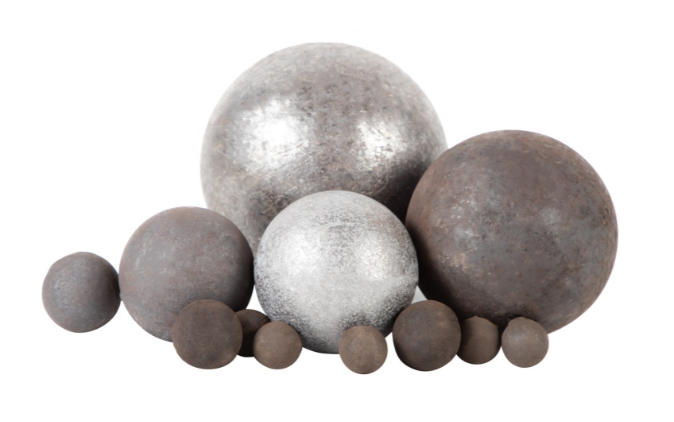Grinding steel balls are key wear-resistant components used for material grinding and refinement. They are widely applied in ball mills across industries such as mining, building materials, metallurgy, chemical engineering, and ceramics. Through impact and grinding interactions with materials and mill liners, they process bulk or coarse-grained materials into fine powders or slurries. Their performance directly affects the grinding efficiency of ball mills, product quality, and production costs.
Steel balls of different materials vary significantly in hardness, toughness, wear resistance, and applicable scenarios, serving as the core basis for selection. The main classifications are as follows:
| Material Type | Main Components | Core Performance Features | Applicable Scenarios |
|---|
| High-Chromium Alloy Cast Balls | Cr (10%-15%), C, Fe, etc. | Extremely high hardness (HRC 58-65), strong wear resistance, low breakage rate | Grinding of high-hardness materials (e.g., iron ore, granite, cement clinker) |
| Medium-Chromium Alloy Cast Balls | Cr (3%-10%), C, Fe, etc. | Moderate hardness (HRC 50-57), better toughness than high-chromium balls, high cost-effectiveness | Grinding of medium-to-low hardness materials (e.g., limestone, coal, gypsum) |
| Low-Chromium Alloy Cast Balls | Cr (1%-3%), C, Fe, etc. | Good toughness, low cost, average wear resistance (HRC 45-52) | Grinding of soft materials or scenarios with low efficiency requirements (e.g., fly ash) |
| Forged Steel Balls | High-quality carbon steel (e.g., 45# steel) or alloy steel | Dense structure, excellent toughness, impact resistance (HRC 50-60) | High-impact working conditions (e.g., large ball mills, coarse grinding stage) |
| Ordinary Cast Steel Balls | Low-carbon steel or low-alloy steel | Extremely low cost, low hardness (HRC 30-40), easy wear | Temporary replacement or grinding of low-value materials (e.g., coarse grinding of construction waste) |
When selecting grinding steel balls, the following parameters must be prioritized to ensure compatibility with ball mill models and material characteristics:
Diameter Specification: The common range is φ20mm-φ150mm, selected based on the inner diameter of the ball mill and the grinding stage (coarse/fine grinding):
Coarse grinding stage: Large-diameter steel balls (φ80mm-φ150mm) are used to crush coarse materials through gravity impact.
Fine grinding stage: Small-diameter steel balls (φ20mm-φ60mm) are used to increase the grinding contact area and improve fine powder output rate.
Hardness (HRC): Rockwell hardness is a core indicator of wear resistance. Higher hardness means stronger wear resistance, but toughness must be balanced (excessively high hardness leads to easy breakage).
Impact Toughness (αk): Measured in J/cm², it reflects the ball’s ability to resist impact and breakage. Steel balls with excessively low impact toughness are prone to "breakage" under high-impact conditions, contaminating materials and reducing efficiency.
Wear Rate: Refers to the proportional weight loss of steel balls during grinding (usually in ‰). A lower wear rate indicates a longer service life, reducing the cost of ball replenishment.
Roundness and Surface Quality: Steel balls with poor roundness, surface cracks, or burrs increase the energy consumption of ball mills, easily cause material jamming, and affect grinding stability.
Different processes determine the microstructural properties of steel balls. The main processes are divided into two categories: casting and forging.
Process Flow: Batching (pig iron, scrap steel, ferrochrome, etc.) → Melting (medium-frequency electric furnace) → Pouring (sand mold/metal mold) → Cooling → Heat Treatment (quenching + tempering) → Grinding → Inspection.
Features: Enables mass production of steel balls with different diameters at controllable costs. By adjusting chromium content and heat treatment processes, hardness and toughness can be flexibly controlled, making it suitable for producing high-chromium and medium-chromium balls.
Process Flow: Selecting round steel billets → Heating (medium-frequency induction heating) → Forging (pneumatic hammer/friction press) → Heat Treatment (quenching and tempering) → Rounding → Inspection.
Features: Forged steel balls have a dense structure and fine grains, with far better toughness than cast balls. However, they require high-quality raw materials (high-quality round steel), are difficult to forge in large diameters, and cost more than cast balls of the same specification.
Rolling Process: Steel billets are rolled into balls by a rolling mill, featuring high efficiency and precision, but only applicable to small-diameter steel balls (φ20mm-φ50mm).
Heat Treatment Optimization: Processes such as "isothermal quenching" can further improve the toughness of high-chromium balls and reduce breakage rates.
Material Characteristics: High hardness (e.g., iron ore, copper ore, quartz sand) and high grinding intensity.
Selection Recommendations: Prioritize high-chromium alloy cast balls (HRC 60-65, impact toughness ≥3J/cm²) or large-diameter forged steel balls (for coarse grinding stages) to avoid ball breakage contaminating concentrates.
Material Characteristics: High hardness of cement clinker and strict fine grinding requirements (finished product fineness usually ≤10% for 80μm sieve residue).
Selection Recommendations: Use high-chromium cast balls (φ30mm-φ60mm) for the fine grinding stage, and medium-chromium cast balls or forged steel balls for the coarse grinding stage to balance efficiency and cost.
Material Characteristics: High requirements for material purity (no metal impurities) and grinding fineness (e.g., ceramic slurry fineness ≤1μm).
Selection Recommendations: Choose high-purity high-chromium cast balls (low impurities) or polished forged steel balls to prevent contaminants from falling off the ball surface and polluting materials.
Material Characteristics: Low hardness of limestone and large grinding volume requirements.
Selection Recommendations: Select medium-chromium cast balls (HRC 52-57) for high cost-effectiveness—excessively high hardness is unnecessary, helping reduce costs.
Causes: Insufficient ball toughness (excessively low impact toughness), mismatched ball diameter with the ball mill (too large/too small), or severe mill liner wear leading to excessive impact.
Solutions: Replace with high-toughness steel balls, adjust the ball diameter ratio, and timely replace worn liners.
Causes: Insufficient ball hardness, material grinding intensity exceeding the ball’s load capacity, or excessively high ball mill speed (increasing sliding friction of balls).
Solutions: Use steel balls with higher hardness (e.g., replacing medium-chromium balls with high-chromium balls) and optimize the ball mill speed (to match the "cataracting" grinding state).
Regular Ball Replenishment: Calculate the ball replenishment cycle based on the wear rate, maintain the ball filling rate in the mill (usually 30%-40%), and avoid reduced grinding efficiency.
Classified Use: Screen worn small-diameter balls for the fine grinding stage, and supplement new large-diameter balls to the coarse grinding stage to improve ball utilization.
Material Cleaning: Prevent metal blocks or large impurities from mixing into materials to avoid abnormal impact and breakage of steel balls.
High Wear Resistance and Low Breakage: Through alloy composition optimization (e.g., adding molybdenum, nickel) and heat treatment upgrades, improve the wear resistance of steel balls while reducing breakage rates to meet "high-efficiency grinding" needs.
Green Production: Promote low-energy melting technologies (e.g., new medium-frequency electric furnaces) and recycled scrap steel utilization to reduce carbon emissions.
Intelligent Selection: Combine ball mill parameters and material characteristics, and use software simulation (e.g., Discrete Element Method, DEM) to optimize ball diameter ratio and filling rate, enabling "customized selection".
Alternative Material Exploration: Materials such as ceramic balls (alumina ceramics) and rubber balls have been developed, but due to high costs or insufficient toughness, they cannot fully replace grinding steel balls and are only used in special high-purity material scenarios.
In conclusion, the selection of grinding steel balls requires balancing "material characteristics, equipment parameters, and cost budget". Rational selection and maintenance can significantly improve ball mill efficiency and reduce overall production costs.



 Send Email
Send Email